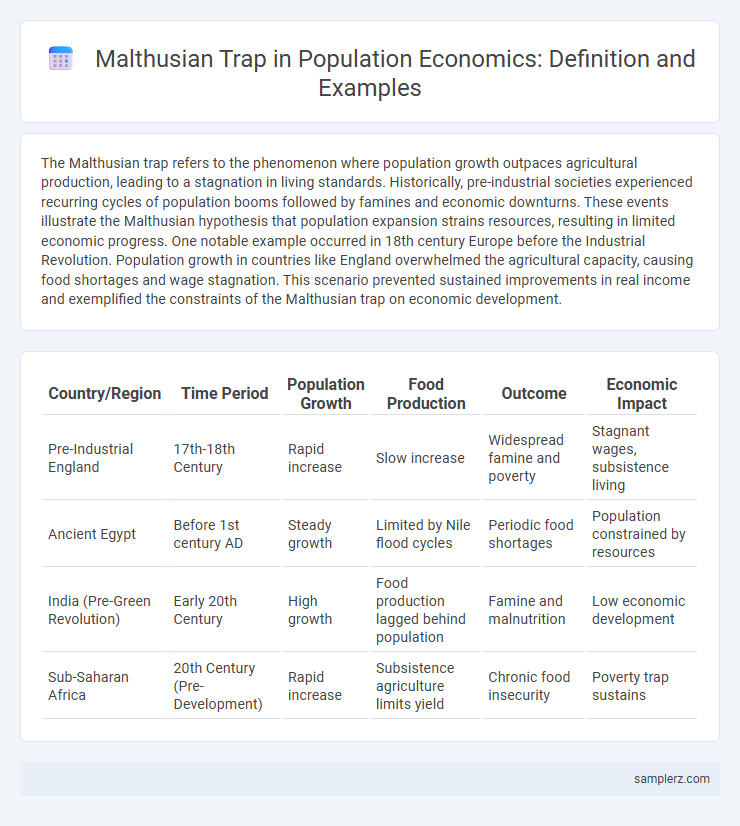The Malthusian trap refers to the phenomenon where population growth outpaces agricultural production, leading to a stagnation in living standards. Historically, pre-industrial societies experienced recurring cycles of population booms followed by famines and economic downturns. These events illustrate the Malthusian hypothesis that population expansion strains resources, resulting in limited economic progress. One notable example occurred in 18th century Europe before the Industrial Revolution. Population growth in countries like England overwhelmed the agricultural capacity, causing food shortages and wage stagnation. This scenario prevented sustained improvements in real income and exemplified the constraints of the Malthusian trap on economic development.
Table of Comparison
| Country/Region | Time Period | Population Growth | Food Production | Outcome | Economic Impact |
|---|---|---|---|---|---|
| Pre-Industrial England | 17th-18th Century | Rapid increase | Slow increase | Widespread famine and poverty | Stagnant wages, subsistence living |
| Ancient Egypt | Before 1st century AD | Steady growth | Limited by Nile flood cycles | Periodic food shortages | Population constrained by resources |
| India (Pre-Green Revolution) | Early 20th Century | High growth | Food production lagged behind population | Famine and malnutrition | Low economic development |
| Sub-Saharan Africa | 20th Century (Pre-Development) | Rapid increase | Subsistence agriculture limits yield | Chronic food insecurity | Poverty trap sustains |
Historical Overview of the Malthusian Trap Concept
The Malthusian trap concept, formulated by Thomas Malthus in the late 18th century, highlights the historical pattern where population growth tends to outpace agricultural production, leading to periodic famines and economic stagnation. Throughout history, especially prior to the Industrial Revolution, societies experienced recurrent cycles of population booms followed by resource scarcity and high mortality rates. This dynamic constrained sustained economic growth until technological advancements allowed food production to increase exponentially, breaking the trap.
The Malthusian Trap in Pre-Industrial Societies
The Malthusian Trap in pre-industrial societies is characterized by population growth outpacing agricultural production, leading to recurrent famines, poverty, and stagnating living standards. Limited technological advancements in agriculture meant that any increase in food supply was quickly absorbed by population growth, preventing sustained economic development. Historical data from Europe and Asia before the Industrial Revolution illustrate cycles of growth followed by sharp declines in population due to resource scarcity and disease.
Population Growth Versus Food Production: Classic Examples
Rapid population growth in 18th-century Britain exemplified the Malthusian trap, where food production lagged behind increasing demand, causing periodic famines and economic stagnation. In pre-industrial societies, limited agricultural technology constrained crop yields, leading to subsistence-level living standards despite population increases. This imbalance underscores how unchecked population growth historically outpaced food supply, reinforcing Malthus's prediction of stagnating per capita income in agrarian economies.
The Irish Potato Famine as a Malthusian Trap Case Study
The Irish Potato Famine (1845-1852) exemplifies the Malthusian trap where rapid population growth outpaced agricultural productivity, leading to widespread famine and mortality. The reliance on a single crop, the potato, made the population vulnerable to disease, highlighting the limits of food supply in supporting demographic expansion. This event underscores how insufficient technological innovation and resource constraints can cause population crises, reinforcing Malthusian theory in historical economic contexts.
Sub-Saharan Africa: Modern Instances of Malthusian Dynamics
Sub-Saharan Africa exemplifies modern instances of the Malthusian trap through its rapid population growth outpacing agricultural productivity, leading to persistent food insecurity and poverty. Limited technological advancement and inadequate infrastructure inhibit improvements in crop yields, reinforcing constraints on per capita resources. This dynamic perpetuates subsistence living conditions and restricts economic development across several countries in the region.
Malthusian Trap Effects on Economic Development
The Malthusian trap describes a scenario where population growth outpaces agricultural production, leading to stagnation in per capita income and persistent poverty. This phenomenon limits economic development by causing resource depletion, reduced investment in capital, and diminished incentives for technological innovation. Historical examples include pre-industrial societies where income per capita remained near subsistence levels despite population increases.
Technological Stagnation and Population Pressure
The Malthusian trap occurs when population growth outpaces agricultural production, leading to technological stagnation and increased population pressure that prevent sustained economic progress. Historical evidence from pre-industrial societies shows that despite technological innovations, gains in productivity were often offset by rapid population increases, causing living standards to stagnate. This dynamic highlights the critical challenge of balancing technological advancement with demographic pressures to avoid subsistence-level economies.
Breaking Free from the Malthusian Trap: The Industrial Revolution
The Industrial Revolution marked a pivotal shift that enabled societies to break free from the Malthusian trap by dramatically increasing productivity and resource availability through mechanization and technological innovation. Innovations in agriculture, such as the seed drill and crop rotation, alongside advancements in manufacturing and transportation, significantly boosted food production and economic output. This shift facilitated sustained population growth without the catastrophic famines and resource shortages characteristic of pre-industrial economies trapped by Malthusian limits.
Demographic Transition and Escaping Malthusian Limits
The Malthusian trap illustrates how population growth can outpace agricultural production, leading to stagnation in living standards. Demographic transition theory explains the shift from high birth and death rates to low birth and death rates, enabling societies to escape Malthusian constraints by stabilizing population growth. Economic development, technological innovation, and improved healthcare contribute to increased productivity, allowing resources to support larger populations without triggering subsistence crises.
Policy Responses and Lessons from Malthusian Trap Examples
Policy responses to the Malthusian trap often include investment in agricultural technology, family planning programs, and education to curb population growth and enhance food production. Historical cases, such as 18th-century Europe, demonstrate that advancements in crop yields and birth rate control effectively mitigated resource shortages. Lessons from these examples emphasize the importance of sustainable resource management and innovation-driven economic policies to break the cycle of stagnation and improve living standards.

example of Malthusian trap in population Infographic
 samplerz.com
samplerz.com